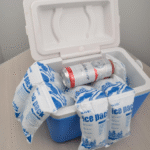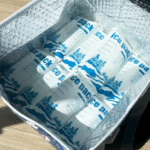Dry Ice Pack Shipping in 2025: How to Ensure Safe and Efficient Cold Chain Logistics
L’expédition de marchandises sensibles à la température nécessite une planification minutieuse, especially when using dry ice to maintain sub-zero temperatures. Dans ce guide, nous allons explorer le fonctionnement des packs de glace carbonique, their applications in various industries, Précautions de sécurité, and how the 2025 cold chain landscape is evolving to meet modern shipping needs.
-
How do dry ice packs work, and why are they crucial for shipping?
-
What are the main uses of dry ice packs across different industries?
-
Quelles précautions de sécurité doivent être suivies lors de la manipulation de glace carbonique?
-
How is dry ice delivery evolving in 2025?
Comment fonctionnent les packs de glace sec, and Why Are They Essential for Shipping?
Dry ice packs are a form of solidified carbon dioxide (Co₂) that sublimates directly from a solid to a gas at -78.5°C (-109.3°F), making them essential for keeping goods frozen during shipping. Contrairement à la glace ordinaire, qui fond et peut causer des dommages liés à l'humidité, la glace carbonique ne laisse aucun résidu, ensuring that products such as vaccines, nourriture, and biological samples remain dry and cold during transport.
Why Dry Ice is More Efficient Than Regular Ice
-
Sans humidité: Dry ice prevents moisture damage by sublimating into gas instead of melting into water.
-
Durée plus longue: It can maintain sub-zero temperatures much longer than regular ice.
-
Superior Cold Retention: La glace sèche maintient une température extrêmement basse, which is crucial for products like vaccines and frozen food.
Main Uses of Dry Ice Packs Across Various Industries
Pharmaceutical and Medical Shipments
Dans l'industrie pharmaceutique, dry ice is indispensable for shipping temperature-sensitive items like vaccines and biologics. De nombreux vaccins, such as those used for COVID-19, require sub-zero temperatures during transit. Dry ice ensures these products remain within the required temperature range.
Industrie alimentaire
Dry ice is also essential in the food industry. It’s used for shipping perishable goods, including frozen foods, fruit de mer, et glace. The cold retention of dry ice helps maintain the freshness and prevent spoilage during long-distance transportation.
Biotechnology and Scientific Shipping
Biotech companies and research labs rely on dry ice to ship sensitive biological samples and chemicals. Dry ice helps maintain the integrity of scientific materials by providing a stable and reliable cooling solution during shipping.
Considérations de sécurité lors de la manipulation de glace sèche
Glace sèche, while extremely effective as a cooling agent, peut présenter des risques en cas de mauvaise manipulation. Here are the essential safety guidelines:
-
Utiliser un équipement de protection: Always wear insulated gloves to prevent frostbite.
-
Assurer une ventilation adéquate: Puisque la neige carbonique se sublime en CO₂, proper ventilation is crucial to avoid suffocation in enclosed spaces.
-
Proper Storage and Packaging: Store dry ice in vented containers to prevent pressure buildup and avoid using airtight packaging.
Exemple du monde réel: A logistics company encountered issues when using airtight containers for dry ice, which led to a burst during transit. Using vented packaging could have prevented this problem.
Trends in Dry Ice Delivery for 2025
Growing Demand for Eco-Friendly Solutions
Sustainability has become a key trend in logistics, with many companies exploring eco-friendly alternatives to traditional dry ice. This includes biodegradable dry ice packs and carbon capture methods that reduce the environmental footprint of shipping.
Advanced Tracking and Monitoring Systems
2025 is seeing an increased use of real-time tracking systems for dry ice shipments. These systems allow businesses to monitor the condition of their products during transit, ensuring they remain within the necessary temperature range.
Innovations in Dry Ice Shipping Containers
New developments in insulated and efficient dry ice containers are helping reduce the amount of dry ice needed for shipments, lowering both costs and environmental impact.
De combien de glace sèche avez-vous vraiment besoin?
The required amount of dry ice depends on several factors, such as the weight of the product, durée d'expédition, et les conditions environnementales. Une ligne directrice générale consiste à utiliser 5 à 10 livres de glace sèche par période de transit 24 heures. For more precise calculations, a formula is often used:
Required dry ice (kg) = Poids du produit (kg) × 0.6 × transit days × temperature factor.
Par exemple, shipping a 20-pound meal kit for two days at -20°C would require around 31 livres de glace sèche.
Packing and Shipping with Dry Ice
Proper packing ensures that dry ice works efficiently throughout the transit. Voici comment procéder:
-
Choisissez le bon conteneur: Use insulated boxes or coolers to maintain the low temperatures.
-
Prepare the Dry Ice: Ensure it’s placed in a vented container to allow for sublimation.
-
Pack the Product: Surround your product with dry ice to maintain consistent cooling.
-
Label and Seal: Secure the container and clearly label it with appropriate hazardous material markings.
Règlements d'expédition
Dry ice shipments are regulated by various organizations, y compris le NOUS. Ministère des Transports (POINT) et le Administration fédérale de l'aviation (FAA) pour le transport aérien. Be sure to follow all packaging, étiquetage, and documentation requirements to ensure compliance.
The Cost of Dry Ice Delivery
Shipping dry ice comes with various costs, including delivery fees and the price per pound. Here’s a summary of typical delivery services:
| Type de fournisseur | Gamme de prix | Minimum Order & Frais | Mieux pour |
|---|---|---|---|
| Local Pickup | $1.50–$3.15 | No minimum | Small quantities for personal use |
| Détaillants en ligne | $0.60–$1.50 | Minimum 10 kg | Ecommerce shipping |
| Emergency Services | Varie | No fixed minimum | Hospitals, centres de données |
| Industrial Suppliers | $2.25 par lb | Minimum 5 lbs | Laboratories, fabrication |
Cost-Saving Strategies
-
Order the Right Quantity: Avoid over-ordering to minimize waste.
-
Compare Pickup vs. Livraison: Pour de plus petites quantités, local pickup may be cheaper.
-
Commandes groupées: Group orders with other businesses to receive discounted rates.
Questions courantes
Q1: What is the difference between dry ice and regular ice for shipping?
Dry ice is much colder and sublimates into gas, while regular ice melts into water, ce qui peut endommager les produits.
Q2: La glace carbonique peut-elle être utilisée pour les expéditions internationales?
Oui, but there are specific regulations on the amount and packaging requirements for international dry ice shipments.
Conclusion et conseils exploitables
Dry ice packs are essential for ensuring the safe transport of temperature-sensitive goods. By selecting the right form, calculating the required amount, et en respectant les règles de sécurité, les entreprises peuvent assurer la sécurité, rentable, and efficient cold chain logistics.
Étapes suivantes:
-
Évaluez vos besoins: Calculate the amount of dry ice required for your shipment.
-
Choose the Right Pack: Select the best dry ice format for your product.
-
Choisissez un fournisseur: Compare prices and services from various suppliers.
-
Prioritize Safety: Follow all safety guidelines when handling dry ice.
À propos du tempk
Tempk specializes in custom cold chain solutions, y compris la glace sèche, packs de gel, et expéditeurs isolés. We provide expert advice, regulatory training, and delivery strategies for industries such as pharmaceuticals, nourriture, et biotechnologie. Contactez-nous dès aujourd’hui pour optimiser votre logistique sous chaîne du froid.























